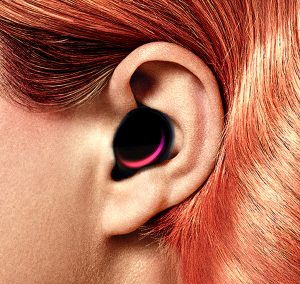
Do you own a smartphone? A smartwatch? Smart earbuds?
Hearables are wireless in-ear devices such as hearing aids, personal sound amplifiers, or earbuds, but instead of just amplifying or transmitting sound, they also sync with a smartphone or other smart device to allow the user to make phone calls, play music, or search the internet via voice, hands-free. Some of these devices are also able to monitor a person’s temperature, heart rate and calories burned, and track their steps. Smart hearing aids sync with smartphone apps in order to allow the user to adjust volume and tone and in some cases turn their hearing aids into headphones for phone calls and audio streaming.
Today’s market size shows worldwide hearable unit sales in 2018 and projected for 2020. In 2016, hearing aid revenue constituted the largest segment of the global hearables market. According to the World Health Organization, more than 5% of the world’s population suffers from hearing loss. Supported by a strong distribution network and audiologists who are increasingly recommending digitally programmable, customized smart hearing aids, demand for these devices is expected to grow through 2023.
In the United States, in August 2017, President Donald Trump signed into law the Over The Counter Hearing Aid Act. This law requires the Food and Drug Administration to regulate over-the-counter hearing aids to ensure they meet the same standards for safety, consumer labeling, and manufacturing that all other medical devices must meet. These regulations must be in place by August 2020. These types of hearing aids will be approved to treat mild to moderate hearing loss in adults. Those with hearing loss will not be required to visit an audiologist or another medical professional to obtain one. Although there are no over-the-counter hearing aid products on the market currently, once guidelines are in place this has the potential to expand the demand for smart hearing aids dramatically. An estimated 38 million Americans have untreated hearing loss.
On December 13, 2016, Apple released the first generation of AirPods, wireless Bluetooth earbuds that allowed users to make phone calls and interact with Apple’s digital assistant Siri. The newest generation of Apple AirPods, released in 2019, along with similar earbuds from other tech companies are expected to drive growth. In 2018, Apple sold an estimated 35 million AirPods, constituting 76% of the market. According to Counterpoint Research’s Consumer Lens study, in the United States, Apple was the preferred brand among consumers (19%), followed by Sony (17%), Samsung (16%), Bose (10%), and Beats (6%).
Geographic reference: WorldYear: 2018 and 2020
Market size: 46 million and 129 million, respectively
Sources: Liz Lee, “True Wireless Hearables Sales to Climb to 129 Million Units Globally by 2020,” Counterpoint Press Release, March 15, 2019 available online here; Lindsey Banks, Au.D., “The Complete Guide to Hearable Technology in 2019,” Everyday Hearing, February 22, 2019 available online here; Lindsey Banks, Au.D., “The FIRST Made for iPhone Hearing Aids,” Everyday Hearing, July 2, 2016 available online here; “Hearable Devices Market Worth 23.24 Billion USD by 2023,” MarketsandMarkets Press Release, July 2017 available online here; “President Trump Signs OTC Hearing Aid Legislation into Law,” The Hearing Review, August 19, 2017 available online here; N.S. Reed, et. al., “Trends in Health Care Costs and Utilization Associated With Untreated Hearing Loss Over 10 Years,” JAMA Otolaryngology – Head Neck Surgery, U.S. National Library of Medicine, National Institutes of Health, November 8, 2018 available online here; “AirPods,” Wikipedia, April 8, 2019 available online here.
Original source: Counterpoint Research’s Emerging Technology Opportunities service.
Image source: Nicolas Sadoc [CC BY-SA 4.0], via Wikimedia Commons. Use of image does not constitute endorsement.
